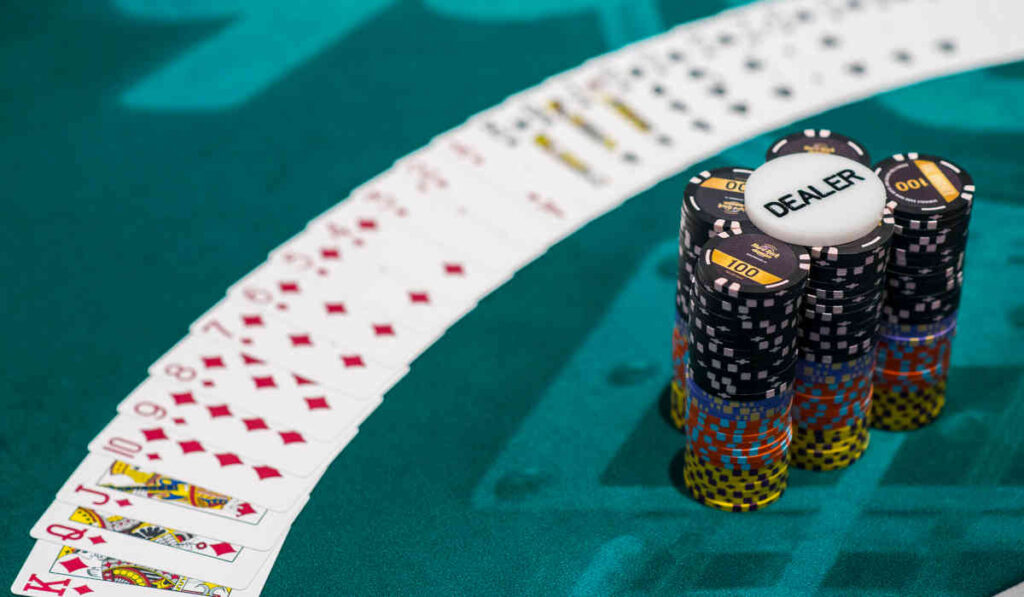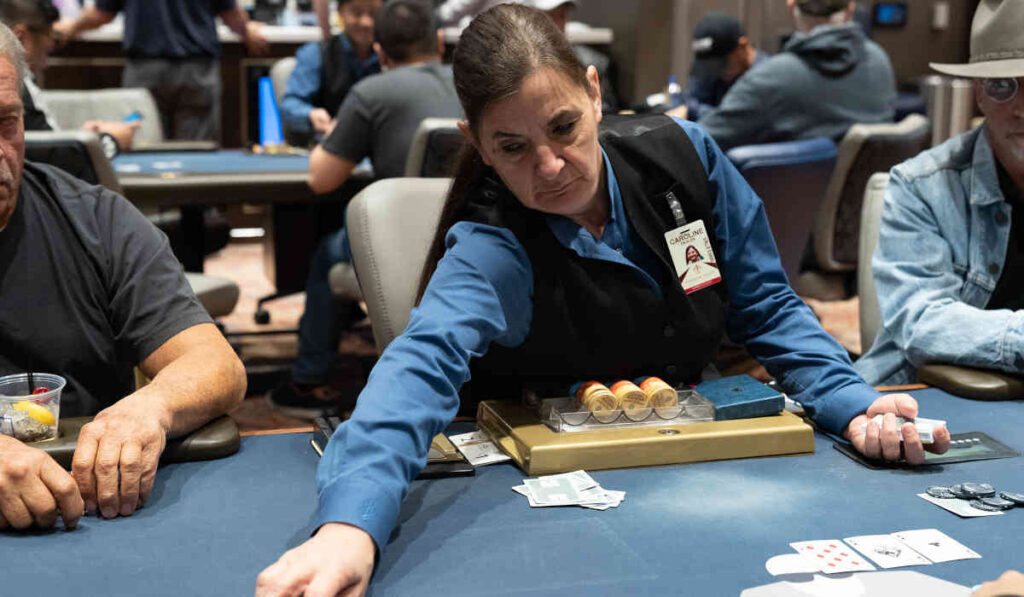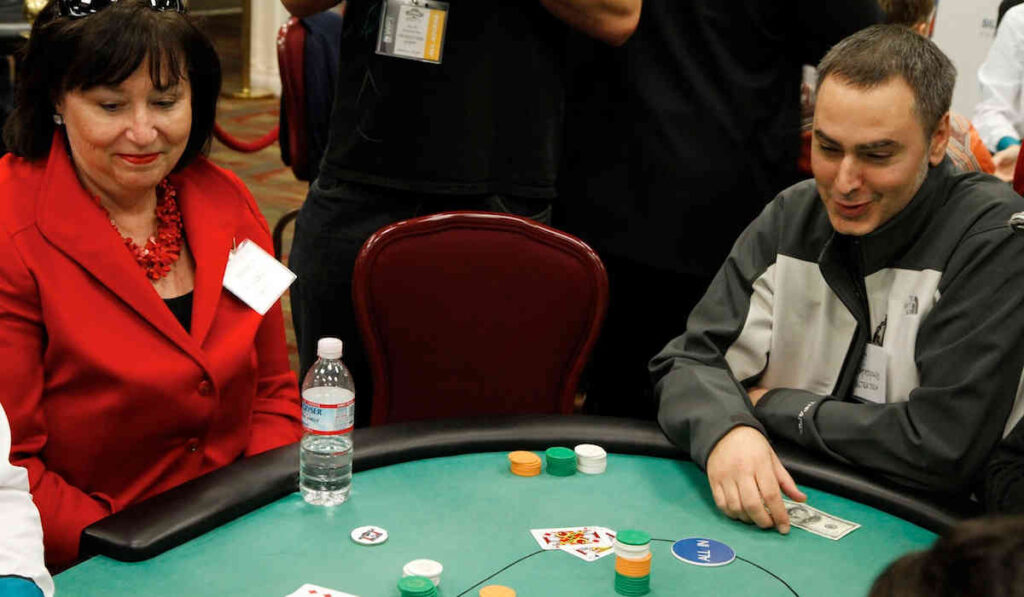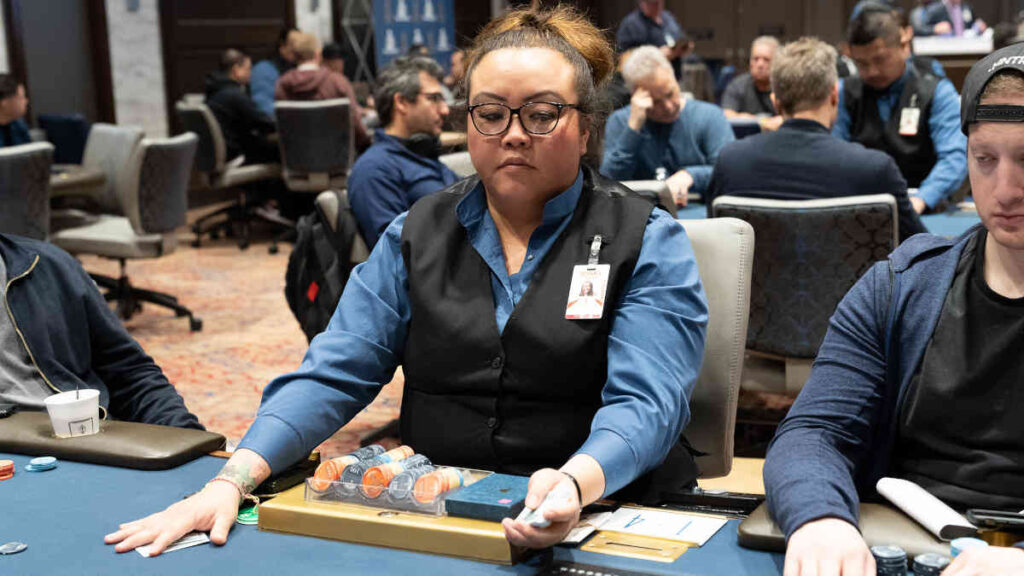Images courtesy of World Poker Tour
A poker dealer’s job may seem quite simple at first glance, but it is actually quite demanding. It requires absolute focus and concentration, as well as mathematical skills and hand-eye coordination.
If you have never dealt Texas Hold’em Poker before, you may be underestimating the number of things a poker dealer has to think about during a poker hand.
Unlike players, who only need to focus when they decide to play a hand, the poker dealer must keep track of every action made by every player in each hand that’s dealt.
If you are preparing to deal your first poker game, this guide will teach you how to deal Texas Hold’em Poker and what to focus on while doing the job.
We will cover all the parts of a poker dealer’s job, from preparing for the game to showdown and beyond.
Getting Ready for the Game
For the players, a poker game starts once they are in their seats and cards are dealt. For the dealer, it starts earlier, as they are responsible for making sure everything is in order for a fair and smooth game of poker.
This is especially the case in private games, as the lack of other staff, such as a floor man, may mean you have extra responsibilities on your shoulders.
For example, a private game dealer may be responsible for handing out chips to the players from the rack, which has to be done with precision so that everyone gets exactly the amount of chips they paid for.
Beyond that, the dealer will usually get a brand-new pack of cards at the start of the game. The deck is unpacked, and the dealer must make sure that all 52 cards are in the deck and display it to all the players.
This is usually done by doing a card spread across the table in a way that all the cards are visible to the players in order, starting with the Ace of Spades.

Of course, if you are dealing a private game, this move may not be necessary, but it’s a handy mechanical skill that will give players extra confidence in your dealing skills.
Once the deck is ready and the players are in their seats, it’s time to start the game by assigning the dealer button.
First Shuffle and the Dealer Button
Once it’s time for the game to start, you will want to shuffle the cards well, especially if you opened a new deck of cards.
Poker dealers around the world use a few card shuffling techniques to ensure randomness and fairness, and these techniques should be used even in a private poker game.
The card scrambling technique is the most efficient way of shuffling cards completely randomly. Spread the cards across the table face down, and scramble them in all directions without any particular order.
The card scramble will ensure the deck is shuffled in a very random way, but you won’t stop there either.
Following the scrambling, put all the cards together and perform three classic card riffles. After the riffles, cut the deck one more time without showing the bottom card to anyone at the table, and you are ready to start the dealing.
Your first job is to assign the dealer button. Do so by dealing one card to each player, starting with the one to your immediate left. The player who receives the highest card will be assigned the dealer button for the first hand.
Round 1 – Hole Cards & Preflop Action
When the dealer is assigned, you will place the dealer button in front of the player, and instruct the two players to their left to post the small blind and the big blind.
You will shuffle the cards in the same way you did before, and start dealing the hole cards. Each player will receive a total of two hole cards in this dealing round.
Preflop dealing starts with the player in the small blind poker position and ends with the dealer. The hole cards are dealt in a circle, with each player receiving one card at a time.
This means you will go around the table twice in order to ensure every player has exactly two hole cards.
Once the hole cards are dealt, the action starts with the player to the left of the big blind, also known as “under the gun.”
Players go around the table taking action. Each player can fold their cards, call the value of the big blind, or make a raise. Players can raise to anywhere between 2x the big blind and their entire stack.

In preflop raising, each new raise must be at least equivalent to the previous raise. For example, if player A raises from $2 to $5, they are raising an extra $3. Player B must make a raise to a minimum of $8 for it to count, etc.
Preflop action goes around the table until all players have acted on their hole cards and all the bets and raises are covered. If all players but one fold their cards, the player automatically wins the hand.
Round 2 – First Community Cards & Flop Action
The next step in how to deal Texas Hold’em Poker is to deal the first community cards. Once preflop action is completed, you will deal the first three community cards, known as the flop.
Before dealing any cards, take one card from the top of the deck and place it face down next to the community card area. This is known as “burning” the card, and is another technique used to ensure game fairness.
Burning cards isn’t necessary in online games since sites like YouBet use random number generators to ensure fairness across the board In live games, though, this is an extra step to put everyone’s mind at ease.
Once the card is burnt, you will deal three cards from the top of the deck into the community card area, face-up.
These three cards make up the flop, and they are the first community cards in the game. All players can use these cards to make their poker hand in combination with their hole cards.
Once the flop is dealt, betting action starts once again. This time around, the UTG player is the first to act, while the dealer is the last to act.
Players who folded their cards before the flop no longer have action. Remaining players in the hand take turns acting on their hand from left to right.
Your job as the dealer is to ensure all bets made are legal and clearly announced to the rest of the players. You will verbally announce the value of each bet and raise, and make it clear whenever a player is all-in.
You will also be responsible for ensuring players adhere to the game rules, including giving back change when they bet or call with oversized chips.
Once you have completed all these tasks and all the players have acted on their hands, you can proceed to deal the next community card.
Round 3 – The Next Community Card & Turn Action
As soon as the flop action is concluded, you can proceed to dealing the next community card, called the turn.
Before dealing the turn card, you will once again discard the top card from the deck by placing it on top of the first burn card.
Now that you’ve burnt a card, you will put out the turn card, face-up, next to the flop. There should now be four community cards in the community card area.
Once again, action starts from the small blind, or the closes player who still has cards. All players still active in the hand take their turns checking or betting.
Once all the turn betting action is completed, it’s time to deal the final community card, known as the river.
Round 4 – Final Community Card & River Action
The final community card is called the river. Before dealing the river card, make sure you burn one last card. There should now be exactly three cards on the burn pile, right next to the community cards.
Place the river card next to the turn card to complete the five-card set of community cards in the community card area.
All the players who still have cards now take turns acting on their hands. The action goes in the same order as it did on the flop and the turn.
Once every player has acted and all the bets are covered, the hand will go to showdown. If all players but one fold their cards at any point throughout the hand, the last remaining player automatically receives the pot.
In all other cases, the hand proceeds to showdown, and the dealer determines the winner.
Showdown – Determining the Winner
Once all the river action is completed, you will announce showdown, provided there is more than one player still in the hand.
In this case, the players will be required to turn over their hole cards. Each player will make their best poker hand from a combination of their two hole cards and the five community cards.
If there was betting on the river, the player who made the last aggressive action (bet or raise) should turn their cards over first. If there were no river betting, players should turn their cards in the same order in which they acted on the flop, turn, and river.
Once the cards are on their backs, you should compare the hand strength in accordance with the official poker hand rankings and announce the winner clearly.

Getting the winner right is one of the most important parts of your job as a poker dealer, so make sure you don’t make any mistakes here.
If there is any confusion, make sure to explain to the players which hand is the winner and why before giving the pot to any player.
Kickers and Splitting the Pot
In case more than one player shows the same hand at showdown, the dealer must determine who the winner is, or whether the hand should result in a split pot.
When two players have the same one pair, two pair, or trips, one of them may still end up winning the pot due to their kicker.
The kicker is the highest card the players have that’s not a part of their made hand. For example, on a board of A72, one player shows AK and another player shows AJ.
Both players have a pair of Aces, but the first player’s King kicker beats the second player’s Jack kicker. In this case, the first player wins the whole pot so you must know what beats what in these situations.
However, if multiple players show the same hand, the pot is split between them. Two or more players may end up splitting the pot. In this case, the dealer divides the pot into equal parts and assigns one portion of the pot to each of the winners.
All-Ins and Side Pots
Keep in mind that in No Limit Texas Hold’em, each player can only win the amount of chips equivalent to their chip stack from each of the players.
If a player bets all of their chips at any point in the hand, they are deemed “all-in.” If other players in the hand have more chips than they do, they may continue betting on later streets. In this case, side pots must be formed.
For example, imagine dealing a $1/$2 game for your friend group. One of the players has $50 remaining and goes all-in before the flop. Three other players call the $50 bet, but they all have more chips in their stacks.
The $50 from each player goes into the main pot. If the remaining players make any further bets after the flop, these chips go into the side pot.
The side pot can only be won by the players who participate in it. The player who moved all-in before the flop cannot win this pot, even if they have the best hand at showdown.
In some situations, you may even have to create multiple side pots if more than one player goes all-in for their last chips at different points in the hand.
When creating side pots, take your time to ensure the pots are correct before proceeding with the card deal.
Practice Makes Perfect with Poker Dealing
You now know how to deal Texas Hold’em Poker in essence, but you will need to practice these skills in order to become a strong poker dealer.
Remember that every part of the card-dealing process is essential to the game. If you make mistakes while dealing, the players suffer the consequences.
When you go into a game of poker, make sure that you are concentrated on your job and that your focus is not divided between the game and other things.
We recommend practicing your dealing skills outside of the game or playing low-stakes games with friends to perfect the skills and ensure that every step of the process becomes second nature.
Once you have spent enough hours dealing cards, you should be comfortable enough to deal for anyone and in any situation, and make the minimal number of mistakes while doing it.


